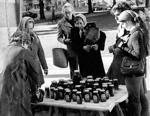In a striking proposal for Downtown’s booming Wilson Street, a developer is proposing a 14-story housing project with first-floor restaurants and a large outdoor plaza offering broad panoramas to Lake Monona.
Quad Capital Partners, of Ann Arbor, Michigan, intends to demolish the State of Wisconsin Investment Board’s two-story building at 121 E. Wilson St. for a project reaching to the Capitol height limit with about 337 apartments, 17,000 square feet of commercial space and multiple levels of underground parking.
The project would feature a 34-foot-wide, two-story-high, open-air promenade cutting through the U-shaped building that would connect East Wilson Street to the plaza overlooking the lake.
The proposal comes amid a surge of redevelopment on the Wilson Street corridor on both sides of Monona Terrace.
People are also reading…
“This location is well-suited to creating a high-quality building that aligns with the city’s plans,” said Dan Kennelly, vice president at QCP. “We believe in investing in Downtown Madison, and this site provides a unique opportunity to create a timeless building that serves the community and helps meet Madison’s housing needs.”

An artist’s rendering of the proposed U-shaped project, as seen from East Wilson Street.
SWIB is moving from its offices to the massive Madison Yards redevelopment under construction at the southwest corner of University Avenue and North Segoe Road on the West Side. QCP bought SWIB’s property at 121 E. Wilson St. for $12.6 million in September, seven months after the agency announced it would be moving. SWIB expects to relocate in early 2023.
‘A new destination’
Given its location, the new structure, designed by Madison-based Potter Lawson, would have a significant impact on the city’s Lake Monona skyline.
“We set out to design a building that is consistent with the city’s plans, sensitive to the neighborhood and takes advantage of this location’s unique opportunity to provide lake views,” Kennelly said.
The U-shaped design allows maximum lake views, while the ends of the U make the building appear less massive from East Wilson Street, Kennelly said. The two sections are separated by a two-story-tall promenade, or open area, cut through the center of the building.
“We envision one side of the commercial space being used for a large chef-driven restaurant and the other side potentially becoming a food hall featuring local food merchants,” Kennelly said. “The promenade and terrace will create 10,400 square feet of outdoor space for outdoor dining, informal seating areas and enjoying views overlooking the lake.”

The proposed 14-story building would rise to the Capitol height limit and sit nestled between the 10-story state Administration Building, left, and the metallic, 12-story Marina condominiums.
He said he hoped the building would “create a new destination for Madison residents.”
“It’s hard to believe that 25 years ago, Potter Lawson was preparing to celebrate the grand opening of Monona Terrace, a project that proudly reshaped the skyline of Madison,” said Rebecca Prochaska, principal at the design firm. “It’s an honor today to be, once again, reimagining the iconic architectural skyline in a town we’ve called home for 109 years.”
A living mix
The building would include a mix of studios and one-, two- and three-bedroom units, Kennelly said. The range of unit types, sizes and rents would serve different segments of the housing market, but the mix would not include designated low-cost units, he said.
“The project is not displacing any existing housing, so it will be an addition to the city’s housing supply and the project will create significant new tax base to support the city’s housing programs,” he said.
The building would also include sustainability features, such as electric vehicle charging stations, green roofs, potential on-site solar and high-efficiency systems throughout. It would offer about 300 parking stalls in a three- or four-level underground parking garage.

The Wilson Street corridor as seen from John Nolen Drive and Lake Monona. The corridor is seeing unprecedented proposals for housing redevelopment.
Downtown Ald. Mike Verveer, 4th District, said he is generally “very supportive” of the proposal and “loves the public promenade concept through the project.” The promenade also has the potential to link the Downtown to Law Park on the lakeshore in the future, he said.
More possibilities
QCP is open to providing the city an easement through the promenade that would allow a future pedestrian bridge connection over railroad tracks and John Nolen Drive to Law Park, Verveer said. The easement would be similar to one secured through a fire lane at McGrath Property Group’s 14-story apartment building at 151 E. Wilson, which opened in 2018, he said. The city could potentially build a bridge to the park from one or both properties.
But he added, “I just wish some of the units could be more affordable.” Also, some in the next-door Marina condominiums have voiced concern about traffic and losing lake views, he said.
At an initial meeting, the First Settlement Neighborhood saw much to like in the early concepts, said Juli Wagner, chair of the First Settlement District of Capitol Neighborhoods Inc. Those include breaking up the mass of the building into two sections facing East Wilson Street and the promenade and plaza allowing views to the lake, she said.
But questions remain about traffic flow, parking, lighting and aesthetics, she said.
The property, currently called Lake Terrace, is nestled between the 10-story state Administration Building, 101 E. Wilson St., and the metallic, 12-story Marina condominiums, 137 E. Wilson St. The city’s Downtown Plan recommends a variety of uses and a maximum height up to the Capitol view height limit, which is no higher than the base of the state Capitol dome.
Lake Terrace, built into the bluff along John Nolen Drive beginning in 1942 with additions in 1957 and 1972, contains 73,363 square feet of space, including 65,000 square feet of office space, with two floors above ground and three floors built into the hillside, including two lower-level floors that face John Nolen Drive and Lake Monona and two levels of underground parking with 100 spaces on the 1.1-acre site. The property was assessed at $7.67 million for 2021 but jumped to $12.6 million for 2022 after the sale.
The QPC proposal “is a tremendous opportunity to help catapult the revisioning and reimagination of Downtown Madison,” said Jason Ilstrup, president of Downtown Madison Inc. “This development will add needed housing to the Madison market all while creating amazing amenities for our community.”
Verveer said he intends to schedule a neighborhood meeting in June.
QCP, which does not anticipate seeking city financial assistance for the project, expects to complete architecture and engineering work and to secure city land use approvals this year, to start construction in 2023 and open the building in early 2025.
Photos: The Dane County Farmers Market then and now
041622farmersmarketkw06-04162022123251

A customer selects a tomato at the Canopy Gardens booth during the Dane County Farmers’ Market on the Square in Madison, Wis., Saturday, April 16, 2022. KAYLA WOLF, STATE JOURNAL
041622farmersmarketkw10-04162022123251

A customer samples cranberry chipotle chutney from Savory Accents at the Dane County Farmers’ Market on the Square in Madison, Wis., Saturday, April 16, 2022. KAYLA WOLF, STATE JOURNAL
Dane County Farmers’ Market

Ted Ballweg, left, of Savory Accents near Verona, talks with a customer at his stand that specializes in products made with organic hot peppers. Ballweg has been selling at the Dane County Farmers’ Market since 1984.
Dane County Farmers’ Market

Mark Olson reaches for an order of cinnamon sticks at his Renaissance Farm stand at the Dane County Farmers’ Market. Olson, of Spring Green, is helping organize a little red wagon project and is recruiting 50 artists to take part in the effort that will be similar to the CowParade and Bucky on Parade.
Dane County Farmers’ Market

A customer selects a basket of tomatoes from Don’s Produce at the Dane County Farmers’ Market. The tomatoes and cucumbers are grown in a hydroponic greenhouse near Arena by Don Uselman, who has been a vendor for 45 years. The potatoes were harvested last fall and stored over the winter.
041622farmersmarketkw11-04162022123251

The Koch family, from left, Eric, Soren and Mandy walk through the Dane County Farmers’ Market on the Square in Madison, Wis., Saturday, April 16, 2022. KAYLA WOLF, STATE JOURNAL
Dane County Farmers’ Market

Despite chilly temperatures, thousands came out Saturday for the season’s first outdoor Dane County Farmers’ Market on Capitol Square. It’s the first April on the Square for the market since 2019, when the COVID-19 pandemic forced officials to move the market to a more spread-out area at the Alliant Energy Center in 2020 and for part of 2021 before returning to the Square in June.
Dane County Farmers’ Market

Garden plants from the Flower Factory were among the Wisconsin-produced items at the Dane County Farmers’ Market on Saturday. Of the 230 members of the market, 49 vendors turned out, but that number will grow as the weather warms, market officials said.
Dane County Farmers Market

A colorful variety of tomatoes and cucumbers are displayed at the Canopy Gardens stand at the Dane County Farmers Market on Saturday.
041622farmersmarketkw02-04162022122747

Sandra Schroerlucke selects a bag of greens from Don’s Produce at the Dane County Farmers’ Market on the Square in Madison, Wis., Saturday, April 16, 2022. KAYLA WOLF, STATE JOURNAL
Dane County Farmers’ Market

Renae Marsh of Canopy Gardens adds more tomatoes to a display at the Dane County Farmers’ Market. Her family farm, which uses a ¾-acre greenhouse to grow tomatoes 11 months of the year, is located near Antigo, 162 miles north of Madison.
Dane County Farmers’ Market

A hip crowd walks the Capitol Square in October 1975 for the Dane County Farmers’ Market.
FARMERS MARKET CROWD 82

DANE COUNTY FARMERS’ MARKET 1982
Dane County Farmers’ Market

At the 1974 Dane County County Farmers’ Market, Robert Mendenhall, left, and Tom Mendenhall came from Plainfield to sell cantaloupe.
Dane County Farmers’ Market

One of the handful of vendors to show up for the inaugural Dane County Farmers’ Market on Sept. 30, 1972, was a farmer from Black Earth who sold seven cases of honey. “I never dreamed we’d sell anywhere as much as we did today,” owner Wesley Rolfs told the Wisconsin State Journal.
FARMERS MARKET WEBSTER

DANE COUNTY FARMERS’ MARKET 1993 (Published on Nov 7 1993) Melody Webster, Madison, selects a peacock feather Saturday as snow flies at the Farmers’ Market on the Capitol Square.
